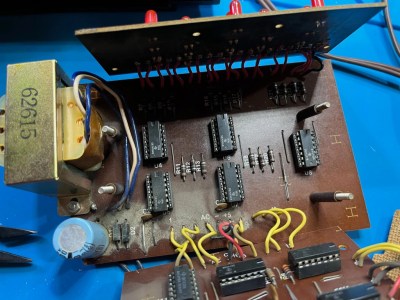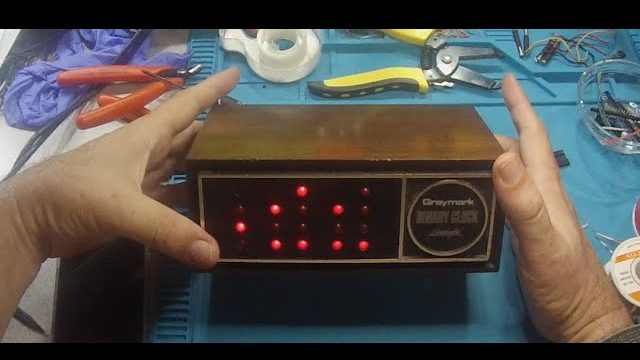Back in 1978, the world was a bit different. There was no Raspberry Pi, no Internet, and not even an ESP32 to build projects with. And rather than order electronics kits from Tindie or Adafruit, [Dr. Francitosh] selected this binary clock with his mother from a catalog, and made the order via mail. Simpler times. The good Doctor, AKA [Greg Smith], was a young electronics tinkerer, and his mother wanted a good project-in-a-box to show off his skills. Thus, a Greymark Binary Clock was ordered and assembled. Then, sadly, the beloved clock crashed from its proud mantle position, doomed to never to blink or blip again. Or was it?
[Greg] finally got his hands on the old project, and just had to get it working again. The inner circuit board was broken right through, and that presented an opportunity to not just repair the clock, but to teach the old dog some new tricks. Before we get there, there’s a fascinating teardown of how the original circuit used a pair of 7490s to take the 50 or 60 Hz of grid power and downconvert it to a stable 1 hz pulse. From there, a series of even more 7490 Binary Coded Decimal counter chips keep track of the ticking seconds, minutes, and hours.

While this clock may be from a simpler time, [Greg] doesn’t live in that time any longer. He saved the project box, panel, original LEDs, and switches. But the new heart of this reborn machine is a Raspberry Pi Pico W. This gives full emulation of the old behavior, as well as setting the time over Bluetooth, grabbing time from NTP, and even listening for the Atomic Clock radio signal. Best of all, the project looks just like it did back in 1978. Mom would be proud.

















Hi Greg! Sending warm wishes to your mother. I hope she is doing well.
Well, if you had read the story in the link (above) you would know that she has passed away.
Apologies for any confusion caused by a quick initial read. Unfortunately, I missed a crucial line that clarified the situation. I sincerely apologize for any unintended impact on your sentiments. Please accept my condolences, and I genuinely hope she rests in peace.
Dear Admin, please delete my comment above, and if it’s possible, the replies that followed. I regret posting it hastily after a careless read, especially on a sensitive topic.
Oh, yeah, Graymark – I had nearly forgotten about them from ye olden days.
It’s incredible to think that for the original functionality of the clock the zillion-transistor complexity of the Pico can be replaced by just a few chips of simple TTL, which would make for a more historically interesting unit. But we all have our own opinions I suppose.
It would have been cool if he kept the original ttl time keeping logic and just used the pico to get the time and set the ttl logic. As designed it is as an actual binary clock
I still have my Graymark Binary clock around here somewhere.
Nice!
I only have a more recent Anelace binary clock clock on my desk.
(The people at the 2nd hand store had no idea what it was and gladly sold it for $2)
B&F Enterprises nixie clock here. TTL and uses line frequency.
I’ve always found it a bit strange that most of the binary clocks are actually BCD, but I guess it’s a lot easier to read then that way.
Graymark Model 540 Binary Clock kit $40 10/1978, if anyone wants to search for more info.
I still have my Graymark 540 clock. Thankfully it has not come crashing to the floor.
Thank you friends for your kind comments.
Mr Rudranand Sahu, no offense taken, I know your comments were meant in good will. My mother loved this clock and she would be warmed by your kind thoughts.
I hear the comments about keeping the original logic and using the Pico to set the time.
It wasn’t an easy decision. Of course I’ve kept all the original circuits. If you have a chance to see the YouTube video, you’ll see I kept the original LEDs, switches, and resistors.
I have other projects where I replace the internal logic with upgraded microcontrollers. And they are also a bit controversial. In many ways it’s the form factor that makes a vintage device look vintage.
As for the Binary Clock. It’s a fond memory and now that I’ve replaced the “kit” with my original circuitry and Python code, I feel it’s more my creation than ever.
Thanks for reposting this article and the attention it’s brought to my work.
Continued Success!
You have no idea how proud I am of my son, Greg Smith. I know his mother would’ve been very
pleased to see the clock run again.
I just found one in a box in the garage. Was in My Father’s office. The hour and minutes don’t illuminate. Hopefully just a broken tracer. The Holy Grail of poorly educated, tinkering men like me. If not the components look easy to replace.